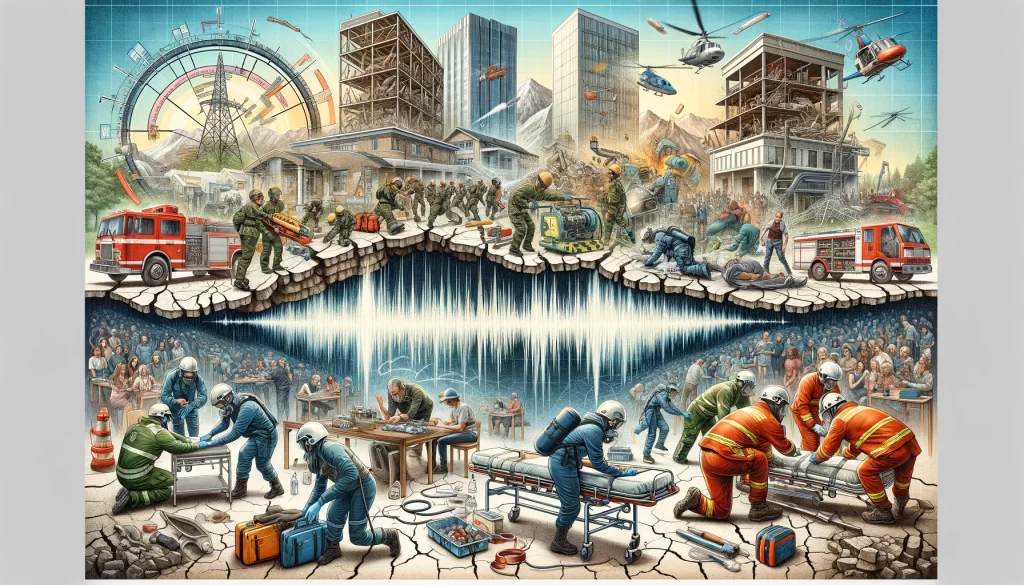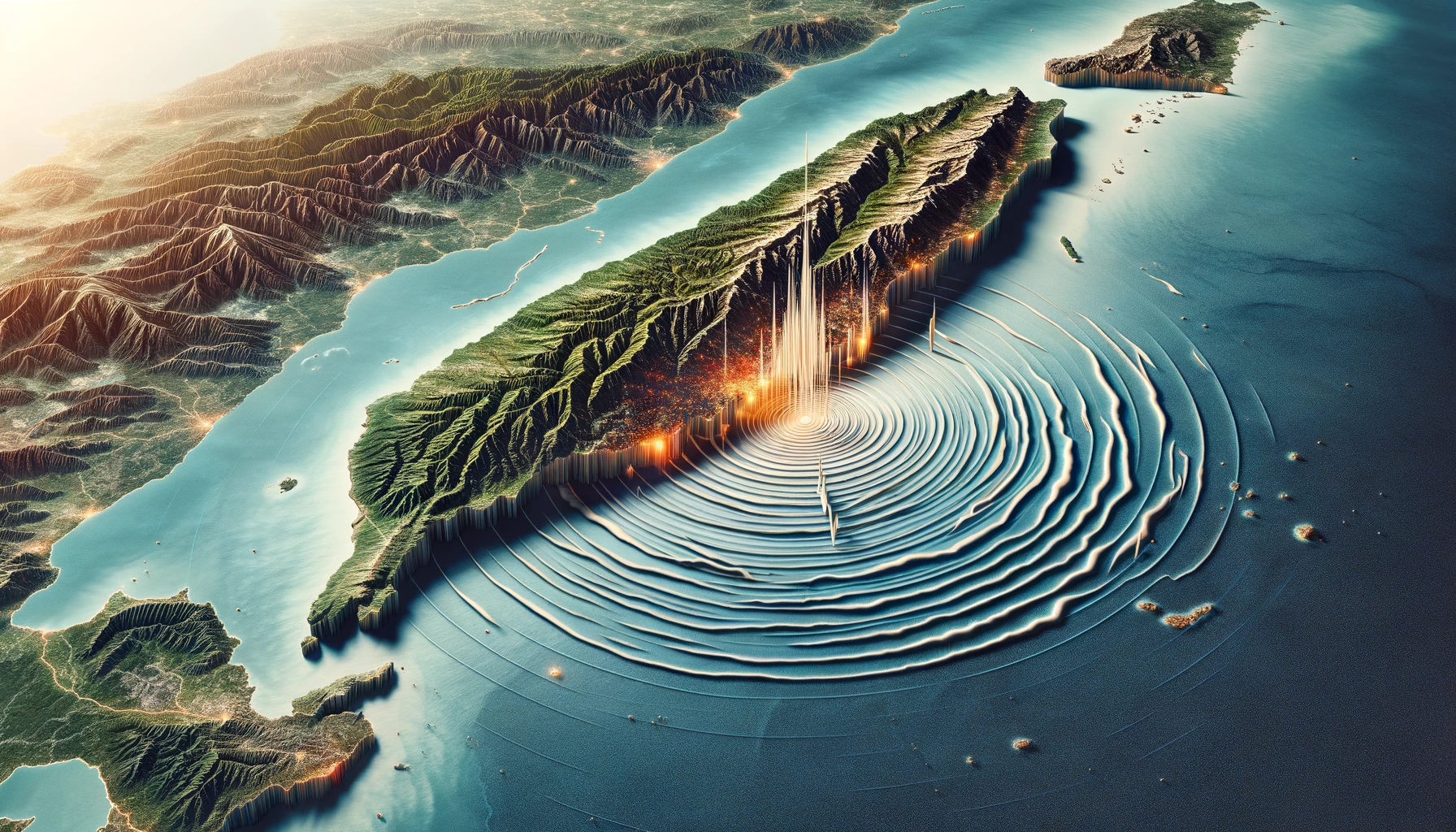On Wednesday morning, during the busiest time of day, Taiwan experienced its most powerful earthquake in 25 years. This massive quake claimed the lives of nine individuals, left over a thousand injured, and caused significant disruption throughout the island.
The epicenter of this tremor was off the coast of Hualien County, a rural and mountainous area. Here, the quake’s impact was visibly dramatic, with some buildings tilting at sharp angles as their lower floors were crushed under the strain. Farther away, in Taipei, the nation’s capital, the quake’s effects were also felt. Older buildings lost tiles, and schools quickly moved students to the safety of sports fields, ensuring each child wore a yellow safety helmet. As aftershocks continued, some children even used their textbooks as shields against potential falling debris.
The response to the earthquake was immediate and widespread. In Hualien, rescuers searched meticulously for those trapped, using heavy machinery to secure unstable structures. The situation was fluid, with numbers of those missing or stranded changing as new reports came in. Among the affected were about 70 workers at two rock quarries, who were safe but cut off from escape due to damaged roads.
The community’s spirit of assistance shone brightly in the quake’s aftermath. Television broadcasts showed neighbors and rescue workers helping residents, including a young toddler, escape their homes through windows, as doors jammed shut from the quake’s force.
Taiwan, familiar with the frequent tremors due to its location on the Pacific “Ring of Fire,” is well-prepared for earthquakes. Yet, this quake caught many off guard. Even those accustomed to the ground shaking were taken aback by the intensity of this particular event. One Taipei resident, Hsien-hsuen Keng, confessed, “I’ve grown accustomed to (earthquakes). But today was the first time I was scared to tears by an earthquake.”
The earthquake struck just before 8 a.m., causing not only human casualties but also environmental and infrastructural damage. Reports indicated that three of the deceased were hikers caught in rockslides within Taroko National Park, a scenic area in Hualien, and another was a van driver whose vehicle was hit by boulders.

In the quake’s immediate aftermath, a tsunami warning was issued, though it was later retracted. The earthquake and its aftershocks led to landslides and damage to roads, bridges, and tunnels across Taiwan. Even the national legislature and parts of the main airport saw minor damage.
Hualien’s mayor reported damage to dozens of residential buildings in the city, with efforts underway to restore water and electricity services. The magnitude of the quake was debated, with Taiwan’s earthquake monitoring agency reporting it as 7.2 and the U.S. Geological Survey suggesting 7.4. Its depth and proximity to the coast amplified its impact.
The quake disrupted transportation across Taiwan, with train and subway services suspended. Despite the initial panic, the resilience of the Taiwanese people and their preparedness for such natural disasters quickly became evident. Schools and public services resumed operations swiftly, demonstrating the community’s ability to adapt and recover.
The earthquake was felt even as far away as Shanghai and various provinces along China’s southeastern coast. Additionally, a tsunami was detected by the Japan Meteorological Agency on the coast of Yonaguni island shortly after the quake, though smaller waves were recorded elsewhere, and all alerts were eventually lifted.
Taiwan’s position along the Pacific “Ring of Fire” means it is no stranger to earthquakes. The most devastating in recent memory occurred in 1999, resulting in thousands of deaths and widespread destruction.
The economic implications of this latest quake are yet to be fully understood, especially considering Taiwan’s crucial role in the global technology sector, particularly in semiconductor manufacturing.
The Taiwan stock exchange opened as usual on Wednesday morning, with the index fluctuating between losses and gains.
This article is based on the following article:
https://apnews.com/article/taiwan-earthquake-tsunami-f086aac0c3082036d1ca77c01828fb28

Background Information
By understanding these aspects, readers can better appreciate the complexities and challenges associated with natural disasters like the earthquake in Taiwan. This background knowledge not only aids in comprehending the specific event described but also in recognizing the broader implications of living in a geologically active region.
Earthquakes and the Pacific “Ring of Fire”
- What Are Earthquakes? Earthquakes are natural phenomena resulting from the sudden release of energy in the Earth’s crust that creates seismic waves. This release of energy often occurs along faults, which are fractures between two blocks of rock in the Earth’s crust.
- The Pacific “Ring of Fire” is a major area in the basin of the Pacific Ocean where many earthquakes and volcanic eruptions occur. It’s shaped like a horseshoe and is associated with a nearly continuous series of oceanic trenches, volcanic arcs, and volcanic belts and plate movements. Taiwan, located on this ring, is prone to earthquakes.
Taiwan’s Geographical and Geological Setting
- Location and Landscape Taiwan is an island in East Asia, located in the Pacific Ocean and situated roughly 160 kilometers (100 miles) off the southeastern coast of China. It features a range of landscapes, including mountains, plains, and beaches. Its diverse topography influences how and where people live and how they respond to natural disasters.
- Taiwan’s Earthquake History The island has experienced numerous earthquakes due to its position on the boundary of two major tectonic plates: the Eurasian Plate and the Philippine Sea Plate. The interaction between these plates causes stress to build up and eventually be released in the form of earthquakes.
Societal Preparedness and Response
- Preparedness for Earthquakes Given its history with earthquakes, Taiwan has developed one of the world’s most advanced preparedness programs. This includes regular drills in schools and workplaces, strict building codes designed to withstand seismic activity, and a sophisticated early-warning system.
- Community and Government Response The rapid response to earthquakes in Taiwan, including evacuations, search and rescue operations, and the restoration of utilities, demonstrates the high level of preparedness and resilience among the Taiwanese people and their government.
Technology and Infrastructure
- Impact on Technology Sector Taiwan is a global leader in semiconductor manufacturing, which is highly sensitive to seismic activities. The earthquake’s potential impact on this sector underscores the interconnectedness of natural disasters and global supply chains.
- Infrastructure Resilience The damage to buildings, roads, and other infrastructure highlighted in the event stresses the importance of earthquake-resistant construction and the continuous evaluation and improvement of existing structures.
Environmental and Economic Considerations
- Landslides and Tsunamis Earthquakes in mountainous and coastal regions like Taiwan can trigger landslides and tsunamis, posing additional risks. Understanding these secondary effects is crucial for comprehensive disaster planning and response.
- Economic Impact The immediate and long-term economic effects of earthquakes can be significant, affecting everything from local businesses to global markets. The recovery and rebuilding process can be costly but also provide opportunities for growth and development.
Please subscribe to Insight Fortnight, our biweekly newsletter!
